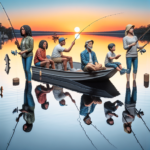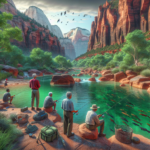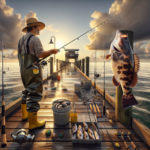Fishing in Lake Okeechobee: Florida’s Largest Freshwater Lake

Introduction
Imagine casting your line into the vast expanse of Florida’s largest freshwater lake, where the thrill of the catch is matched only by the beauty of the surrounding landscape. Lake Okeechobee, often referred to as the “Big O,” is a fishing paradise that attracts anglers from all over the world. Covering over 730 square miles, this lake is not only a haven for fishing enthusiasts but also a vital part of Florida’s ecosystem.
In this article, we will delve into the rich history and geographical significance of Lake Okeechobee, explore the best fishing techniques and species to target, and provide practical tips for making the most of your fishing trip. Whether you’re a seasoned angler or a novice looking to cast your first line, this guide will equip you with everything you need to know about fishing in Lake Okeechobee.
Background/Context
Historical or Cultural Significance
Lake Okeechobee has long been a cornerstone of Florida’s natural and cultural heritage. The name “Okeechobee” is derived from the Hitchiti words “oki” (water) and “chubi” (big), aptly describing this massive body of water. Historically, the lake has been a crucial resource for the indigenous peoples of the region, providing food, water, and transportation routes.
In the early 20th century, the lake became a focal point for agricultural development, particularly for sugarcane and citrus farming. Today, it remains a vital water source for South Florida and plays a significant role in the region’s water management and flood control systems.
Geographical Overview
Located in the heart of Florida, Lake Okeechobee is bordered by five counties: Glades, Okeechobee, Martin, Palm Beach, and Hendry. The lake’s shallow waters, averaging about 9 feet in depth, are surrounded by a diverse ecosystem that includes marshes, swamps, and wetlands. The climate is typically warm and humid, with a rainy season from May to October, which can significantly impact water levels and fishing conditions.
Key Points/Details
Fishing Techniques
Technique Overview
Lake Okeechobee offers a variety of fishing techniques suitable for different species and conditions. Some of the most popular methods include:
- Live Bait Fishing: Using live shiners or minnows is highly effective for catching largemouth bass.
- Artificial Lures: Crankbaits, spinnerbaits, and soft plastics are commonly used to mimic the prey of various fish species.
- Fly Fishing: Though less common, fly fishing can be rewarding, especially for targeting panfish and bass in shallow waters.
When and Where to Use
The best fishing spots and techniques can vary depending on the season and water conditions. For instance:
- Spring: Focus on shallow areas with vegetation, where bass are likely to spawn. Use soft plastics and topwater lures.
- Summer: Fish deeper waters or shaded areas during the heat of the day. Crankbaits and spinnerbaits work well.
- Fall: Target the edges of weed beds and drop-offs. Live bait and jigs are effective.
- Winter: Fish in deeper channels and around structures. Slow-moving lures and live bait are recommended.
Recommended Gear
For a successful fishing trip on Lake Okeechobee, consider the following gear:
- Rods: Medium to heavy action rods for bass fishing; light to medium action rods for panfish.
- Reels: Baitcasting reels for precision casting; spinning reels for versatility.
- Lines: Braided line for heavy cover; fluorocarbon for clear water conditions.
- Bait/Lures: Live shiners, crankbaits, spinnerbaits, soft plastics, and jigs.
Species Information
Species Overview
Lake Okeechobee is home to a variety of fish species, making it a prime destination for anglers. Key species include:
- Largemouth Bass: The most sought-after species, known for their size and fighting spirit. They prefer areas with vegetation and structures.
- Bluegill: Abundant and easy to catch, making them ideal for beginners. They thrive in shallow, weedy areas.
- Crappie: Popular during the cooler months, often found around submerged structures and brush piles.
- Catfish: Found in deeper waters and channels, especially during the warmer months.
Best Practices
To increase your chances of a successful catch, consider these tips:
- Largemouth Bass: Use live shiners or soft plastics near vegetation. Early morning and late afternoon are prime times.
- Bluegill: Small hooks and live bait like worms or crickets work best. Fish near docks and weed beds.
- Crappie: Use small jigs or minnows around submerged structures. Early spring and late fall are peak seasons.
- Catfish: Use stink baits or cut bait in deeper waters. Night fishing can be particularly effective.
Location Information
Top Fishing Spots
Lake Okeechobee offers numerous fishing spots, each with its unique characteristics:
- Clewiston: Known as the “Bass Capital of the World,” this area offers excellent access to prime bass fishing spots.
- Harney Pond Canal: A popular spot for crappie and bluegill, with easy access and ample parking.
- Rim Canal: Runs along the perimeter of the lake, providing opportunities for various species, especially during high water levels.
- Monkey Box: A remote area known for its abundant vegetation and excellent bass fishing.
Regulations and Licenses
Before heading out, ensure you are familiar with local fishing regulations:
- Licenses: A Florida fishing license is required for all anglers aged 16 and older. Licenses can be purchased online or at local retailers.
- Catch Limits: Be aware of daily bag limits and size restrictions for each species. For example, the daily limit for largemouth bass is five fish, with only one allowed over 16 inches.
- Seasonal Restrictions: Some areas may have seasonal closures or specific regulations to protect spawning fish.
Seasonal Considerations
Seasonal Variations
Fishing conditions on Lake Okeechobee can vary significantly throughout the year:
- Spring: Spawning season for bass, making it an excellent time for shallow water fishing.
- Summer: High temperatures can drive fish to deeper, cooler waters. Early morning and late evening are the best times to fish.
- Fall: Cooler temperatures and stable water levels make for consistent fishing conditions.
- Winter: Fish tend to congregate in deeper waters. Slow-moving lures and live bait are effective.
Best Times to Fish
The optimal times for fishing on Lake Okeechobee are:
- Early Morning: Fish are most active during the cooler hours of the day.
- Late Afternoon: As temperatures drop, fish become more active again.
- Night Fishing: Particularly effective for catfish and bass during the summer months.
Events and Tournaments
Event Overview
Lake Okeechobee hosts several fishing tournaments and events throughout the year:
- FLW Tour: One of the most prestigious bass fishing tournaments, attracting top anglers from around the world.
- Big O Open: A popular local tournament with categories for various species and skill levels.
- Crappie Masters: A national crappie fishing tournament that includes a stop at Lake Okeechobee.
Preparation Tips
To prepare for a fishing tournament, consider the following tips:
- Gear: Ensure your gear is in top condition, with extra lines, hooks, and lures.
- Practice: Spend time on the lake before the event to familiarize yourself with the conditions and prime fishing spots.
- Strategy: Develop a game plan based on weather forecasts, water levels, and recent fishing reports.
Tips and Best Practices
General Tips
Here are some practical tips to enhance your fishing experience on Lake Okeechobee:
- Stay Informed: Keep up with local fishing reports and weather forecasts to plan your trip effectively.
- Be Patient: Fishing can be unpredictable, so patience and persistence are key.
- Respect Nature: Follow all regulations and practice catch and release to preserve the lake’s ecosystem.
Avoid Common Mistakes
To avoid common pitfalls, consider these tips:
- Overloading Gear: Bring only the essentials to avoid clutter and confusion.
- Ignoring Weather: Always check the weather forecast and be prepared for sudden changes.
- Neglecting Local Advice: Listen to local anglers and guides who know the lake well.
Advanced Techniques
For those looking to take their fishing skills to the next level, try these advanced techniques:
- Flipping and Pitching: Effective for targeting bass in heavy cover and vegetation.
- Drop Shotting: A finesse technique for catching bass in deeper waters.
- Using Electronics: Utilize fish finders and GPS to locate fish and navigate the lake more effectively.
Gear and Equipment Recommendations
Essential Gear
For a successful fishing trip on Lake Okeechobee, you’ll need the following essential gear:
- Rods and Reels: Medium to heavy action rods with baitcasting or spinning reels.
- Lines: Braided and fluorocarbon lines for different conditions.
- Bait and Lures: Live shiners, crankbaits, spinnerbaits, soft plastics, and jigs.
- Tackle Box: Stocked with hooks, weights, swivels, and other essentials.
Optional Gear/Upgrades
Consider these additional items to enhance your fishing experience:
- Fish Finder: Helps locate fish and underwater structures.
- GPS Device: Useful for navigation and marking fishing spots.
- Polarized Sunglasses: Reduces glare and helps spot fish in the water.
Where to Buy or Rent
You can purchase or rent fishing gear from local shops or online retailers:
- Local Shops: Visit stores in Clewiston, Okeechobee, or other nearby towns for expert advice and gear.
- Online Retailers: Websites like Bass Pro Shops, Cabela’s, and Amazon offer a wide range of fishing equipment.
Safety and Conservation
Safety Tips
Ensure a safe fishing trip by following these guidelines:
- Weather Awareness: Monitor weather conditions and be prepared for sudden changes.
- Life Jackets: Always wear a life jacket when on a boat.
- Hydration and Sun Protection: Stay hydrated and use sunscreen to protect against sunburn.
Conservation Practices
Help preserve Lake Okeechobee’s ecosystem by practicing sustainable fishing:
- Catch and Release: Release fish that are not intended for consumption to maintain healthy populations.
- Respect Wildlife: Avoid disturbing local wildlife and their habitats.
- Follow Regulations: Adhere to all fishing regulations and guidelines to protect the lake’s resources.
Planning Your Trip
Accommodations
Consider these options for places to stay near Lake Okeechobee:
- Hotels: Clewiston and Okeechobee offer a range of hotels and motels.
- Campgrounds: Several campgrounds around the lake provide a more immersive outdoor experience.
- Vacation Rentals: Look for cabins or vacation homes for a comfortable stay.
Travel Tips
Here are some tips for getting to Lake Okeechobee:
- Driving: The lake is accessible via major highways, including US-27 and US-441.
- Air Travel: The nearest major airports are in West Palm Beach and Fort Myers, both about a 1.5-hour drive from the lake.
- Local Transportation: Consider renting a car for convenience and flexibility.
Additional Activities
If you have extra time, explore these activities in the area:
- Hiking and Bird Watching: The surrounding wetlands are home to diverse wildlife and scenic trails.
- Boating: Rent a boat to explore the lake and its many fishing spots.
- Local Attractions: Visit nearby towns for dining, shopping, and cultural experiences.
Frequently Asked Questions (FAQs)
Do I need a fishing license to fish in Lake Okeechobee?
Yes, a Florida fishing license is required for all anglers aged 16 and older. Licenses can be purchased online or at local retailers.
What is the best time of year to fish in Lake Okeechobee?
The best time to fish depends on the species you’re targeting. Spring is excellent for bass fishing, while fall and winter are great for crappie. Early morning and late afternoon are generally the best times of day.
Can I rent fishing gear near Lake Okeechobee?
Yes, several local shops offer gear rentals, including rods, reels, and boats. It’s a good idea to call ahead to check availability.
Are there any fishing tournaments held at Lake Okeechobee?
Yes, Lake Okeechobee hosts several fishing tournaments throughout the year, including the FLW Tour, Big O Open, and Crappie Masters.
What safety precautions should I take when fishing on Lake Okeechobee?
Always wear a life jacket when on a boat, monitor weather conditions, stay hydrated, and use sunscreen. Be aware of local wildlife and follow all safety guidelines.
Conclusion
Fishing in Lake Okeechobee offers an unparalleled experience for anglers of all skill levels. From its rich history and diverse ecosystem to its prime fishing spots and abundant species, the “Big O” is a destination that should be on every angler’s bucket list. By following the tips and guidelines provided in this article, you’ll be well-prepared to make the most of your fishing adventure. So grab your gear, head to Lake Okeechobee, and get ready for an unforgettable fishing experience!




